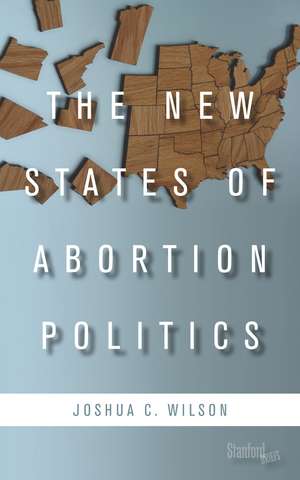The New States of Abortion Politics
Autor Joshua Wilsonen Limba Engleză Paperback – 7 iun 2016
With the end of clinic-front activism, lawyers and politicians took on the fight. Anti-abortion activists moved away from a doomed frontal assault on Roe v. Wade and adopted an incremental strategy—putting anti-abortion causes on the offensive in friendly state forums and placing reproductive rights advocates on the defense in the courts. The Supreme Court ruling on Whole Woman's Health v. Hellerstedt in 2016 makes the stakes for abortion politics higher than ever. This book elucidates how—and why.
Preț: 103.91 lei
Nou
19.89€ • 21.59$ • 16.70£
Carte tipărită la comandă
Livrare economică 23 aprilie-07 mai
Specificații
ISBN-10: 080479202X
Pagini: 128
Dimensiuni: 127 x 203 x 8 mm
Greutate: 0.14 kg
Editura: Stanford University Press
Colecția Stanford Briefs
Recenzii
Notă biografică
Cuprins
This chapter provides a broad and detailed view of contemporary abortion politics. It specifically uses Massachusetts's turbulent history of attempts to regulate antiabortion activism in front of clinics to introduce McCullen v. Coakley¿the book's central Supreme Court case¿and uses it to expose the more contentious and visible phase of abortion politics. It goes on to explore the assent and effect of professional elites and the complexity of abortion politics that exists even within a state that many simply assume to be liberal and in support of abortion rights.
The second chapter focuses on the importance of professional legal resources for the contemporary politics of abortion. If a movement is going to be successful in court, it needs to work to develop or acquire and support premier legal talent. The New Christian Right, inclusive of the antiabortion movement, has rapidly and effectively done so as evidenced by a close examination of the lawyers and legal organizations involved in McCullen v. Coakley.
The third and final chapter places McCullen v. Coakley within the broader contexts of both the history and contemporary state of abortion politics in order to discuss the possible future of the broader conflict. The step back taken in this chapter allows one to better understand why abortion is a contentious issue in the United States, and how the judiciary generally, and the United States Supreme Court specifically, have been the formative engines of abortion politics. The essay's discussion up through Texas House Bill 2 and the resulting Supreme Court case of Whole Woman's Health v Hellerstedt help demonstrate that although the specifics change over time, the established fundamentals of the political process will likely continue to dictate the future forms of the conflict.













